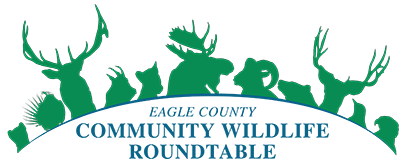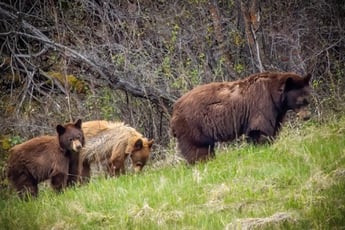Spring is in the Air and so are Bears…& Trash

Eagle County Community Wildlife Roundtable
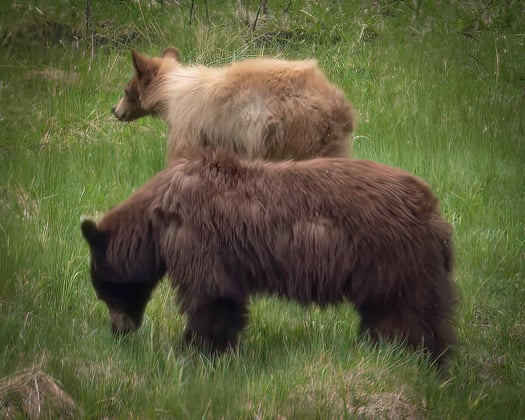
It’s time! Bears are coming out from their long winter naps. Typically bears hibernate from November through mid-March, and they wake up hungry. Most commonly, male bears (boars) are the first to emerge from their dens, followed by females (sows) without cubs. Lastly, usually in late April, females with cubs emerge from their dens sometimes with as many as four cubs - that’s a lot of hungry bear mouths to feed!
Bears are amazing animals, they are curious, intelligent and very resourceful. To help bears maintain their lives in their natural habitat and to reduce human-bear conflicts means that we need to be vigilant to not tempt bears into our neighborhood for easily accessible and tasty trash. Bears have noses that are 100 times more sensitive than humans, they can smell food from 5 miles away, that means they can smell our trash from way up on a hillside. When spring is in the air and they are waking up, there is not as much natural forage for them so human trash is a prime food source, and one they don’t forget, which can become a long-term problem in the neighborhood.
 Black bears are common in Eagle County. Following some simple advice can help up live with the wildlife without problems.
Black bears are common in Eagle County. Following some simple advice can help up live with the wildlife without problems.
In early spring bears will forage on available natural foods such as grasses and aspen buds that may be beginning to sprout. Natural vegetative forage is easy for them to digest after not eating during hibernation. A bear’s natural diet is over 90% grasses, berries, fruits, nuts and native plants, but when they awake in the mountains there is not as much of those natural resources available. A lack of natural food in the springtime can make human-food sources (trash) an easy target and even more attractive when not properly secured and contained in bear-proof receptacles.
Colorado Parks & Wildlife (CPW) reports that there are 17,000-20,000 bears in Colorado who are sharing spaces with our ever-growing human population. Although bears are wary of people and not naturally aggressive and tend to run away from people, if they are intent on getting a meal they could damage property, vehicles, homes, and even injure people. They do not know they are doing anything wrong, they are just hungry.
Trash and recycling haulers are left with the untidy (and disrespectful on our part) task of picking up trash that bears and other scavengers have torn through when garbage is not properly secured in bear/wildlife resistant containers and when left out overnight. Some areas in Eagle County are fortunate to have commercial composting which needs to be placed in secure containers. And, if composting at home, please use an enclosed composting system and avoid putting meat or fruit scraps onto your composting pile. A little known fact is that it is actually a violation of state law, and some local and county ordinances to leave attractants, like trash cans and bird feeders out and in reach or accessible to bears.
 Black bears will cruise the neighborhoods looking for unsecured trash, pet foods left outside, and bird feeders.
Black bears will cruise the neighborhoods looking for unsecured trash, pet foods left outside, and bird feeders.
Since March of 2024, Colorado Parks & Wildlife (CPW) has partnered with Eagle County to promote a pledge-based NeighBEARhood ambassador program. The NeighBEARhood ambassador program is an easy way for residents, visitors and businesses to adopt best practices to promote a safe and healthy environment to reduce human-bear conflicts. The campaign consists of marketing and messaging tools to spread the word to family, friends and coworkers through social media networks, homeowner associations and business organizations in our neighborhoods and in Eagle County to achieve overall safety measures to raise awareness on bear safety.
Once you’ve taken the pledge and become a NeighBEARhood ambassador, take advantage of the toolkit. In it are fun graphics, videos, social media templates, email signature templates, and flyers that are available in both English and Spanish to share and spread the word. To further help CPW, Eagle county is also working with local waste management companies to provide opportunities for customers to acquire proper trash and recycling receptacles. To take the pledge, go to the landing page to “Become a NeighBEARhood Ambassador” on Eagle County’s website at www.eaglecounty.us.
Become Bear Aware
Colorado Parks and Wildlife reminds people to take simple precautions to avoid human/wildlife conflicts and help keep bears wild.
Bear-proofing your home and business:
- Keep garbage in a well-secured location. Only put out garbage on the morning of pickup.
- Clean garbage cans regularly to keep them free of food odors: ammonia is effective.
- Keep garage doors closed. Do not leave pet food or stock feed outside.
- Use a bear-resistant trash can or dumpster.
- Bird feeders are a major source of bear/human conflicts. Attract birds naturally with flowers and water baths. Do not hang bird feeders from April 15 to Nov. 15.
- Don’t allow bears to become comfortable around your house. If you see one, haze it by yelling, throwing things at it and making loud noises to scare it off.
- Secure compost piles. Bears are attracted to the scent of rotting food.
- Clean the grill after each use, and clean up thoroughly after cookouts.
- If you have fruit trees, don't allow the fruit to rot on the ground.
- Talk to your neighbors and kids about being Bear AwareBear
-1.jpeg?width=800&height=640&name=SpilledTrash%20(1)-1.jpeg)
Photo by Allan Finey
The bears know when it is trash day. They will find unlocked or over loaded trash cans for some easy calories.
CPW believes that human-bear conflicts can be mitigated if strategies like the NeighBEARhood ambassador program are implemented in partnership with our local communities. One of the primary concerns is human health and safety when considering the implementation of bear management practices. The knowledge CPW has on these best-practices management tools have evolved through many studies over time and are developed through a deep understanding of bear behavior. This is the time, with spring in the air, to do our part to contribute to the effort of reducing human-bear conflicts and take the NeighhBEARhood ambassador pledge.
It is easy and your efforts will help encourage other residents, businesses and visitors that “starting with proper bear aware practices in the spring may help prevent bears from discovering your home or neighborhood as a food source that they will return to throughout the year. Every action counts. By reducing attractants, we help to prevent bear relocations and give these incredible animals a real chance at survival.”
Kathryn Middleton has lived in Vail since 1982. She is a member of the Eagle County Community Wildlife Roundtable and participates in the Education/Outreach Committee. She also serves on the board for the Mountain Valley Horse Rescue in McCoy, Colorado.
The Eagle County Community Wildlife Roundtable is a collaborative partnership with the White River National Forest, Colorado Parks and Wildlife, Bureau of Land Management, local government entities, community members, and citizen scientists. The purpose of the Eagle County Community Wildlife Roundtable is to gather a group of diverse stakeholders in the valley to understand and address issues facing wildlife populations. Together we will identify a shared vision and realistic actions that the community can rally around to support wildlife. We want to leverage diverse values, creativity, and resources to move toward positive action.
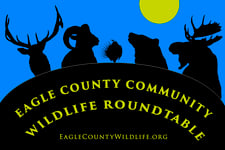
Eagle County Community Wildlife Roundtable
The Eagle County Community Wildlife Roundtable is a collaborative partnership with the White River National Forest, Colorado Parks and Wildlife, Bureau of Land Management, local government entities, community members, and citizen scientists. The purpose of the Eagle County Community Wildlife Roundtable is to gather a group of diverse stakeholders in the valley to understand and address issues facing wildlife populations. Together we will identify a shared vision and realistic actions that the community can rally around to support wildlife. We want to leverage diverse values, creativity, and resources to move toward positive action.
Blog posts
Related Articles.
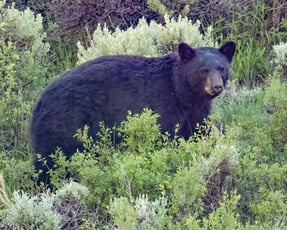

Rick Spitzer
Be an Eagle County NeighBEARhood Ambassador!
If you live in Eagle County, you’ve made your home in black-bear habitat. Black bears (Ursus...
